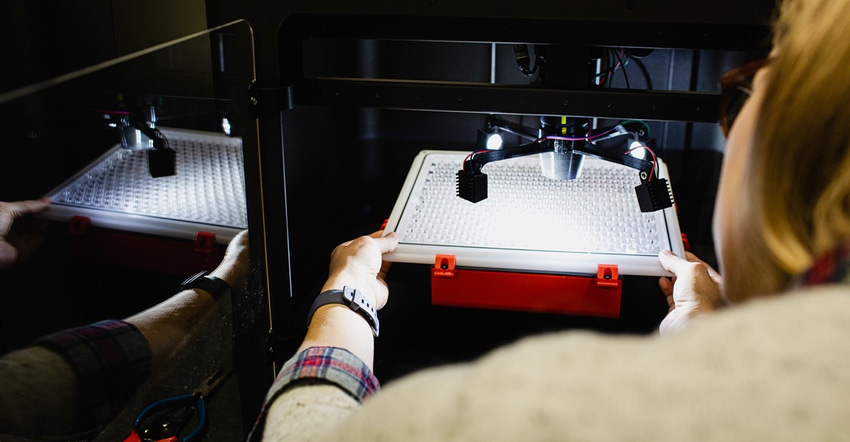August 25, 2021

New technology, using robotics and artificial intelligence, is supercharging efforts to protect grapes and soon will be available to researchers nationwide.
Biologist Lance Cadle-Davidson, an adjunct professor in Cornell’s School of Integrative Plant Science (SIPS) and a research plant pathologist with USDA’s Agricultural Research Service, is developing grape varieties that are more resistant to powdery mildew, which can show up in infrared before it is visible to the naked eye. But his lab’s research has been bottlenecked by the need to manually assess thousands of grape leaf samples for evidence of infection.
So, his team has developed prototypes of imaging robots that can scan grape leaf samples automatically — a process called high-throughput phenotyping — through the USDA-ARS-funded VitisGen2 grape-breeding project and in partnership with the Light and Health Research Center.
This partnership led to the creation of a robotic camera they named “BlackBird.”
BlackBird can gather information at a scale of 1.2 micrometers per pixel — equivalent to a regular optical microscope. For each 1-centimeter leaf sample being examined, the robot provides 8,000-by-5,000 pixels of information.
Extracting useful information from such a large, high-resolution image was the challenge for engineer and computer scientist Yu Jiang, an assistant research professor in SIPS’ horticulture section at Cornell AgriTech, and his team used artificial intelligence to solve it.
Using breakthroughs in deep neural networks developed for computer vision tasks such as face recognition, Jiang applied this knowledge to the analysis of microscopic images of grape leaves. In addition, Jiang and his team implemented the visualization of the network inferential processes, which help biologists better understand the analysis process and build confidence with AI models.
Joint project
Working together, Cadle-Davidson’s team tests and validates what the robots see, enabling Jiang’s team to teach these robots how to identify biological traits more effectively. The results are astounding, Cadle-Davison says. Research experiments that used to take his entire lab team six months to complete now take the BlackBird robots only one day.
“It has revolutionized our science,” he says. “And we’re finding that Yu’s AI tools actually do a better job of explaining the genetics of these grapes than we can do sitting at a microscope for months at a time doing backbreaking work.”
In July, the team was awarded a two-year, $150,000 grant from the Cornell Institute for Digital Agriculture Research Innovation Fund to begin upgrading the BlackBird robot to see beyond the red-green-blue color spectrum and into infrared.
If the researchers can develop tools to help farmers detect disease early, it would enable farmers to target fungicides before infection spreads, meaning less fungicide and fewer lost crops. They’re also working to integrate AI more effectively with scientists in data analysis.
They also were awarded a $100,000 grant from USDA-ARS to disseminate BlackBird to ARS field offices working on other crops that do the same kind of high-throughput phenotyping work.
“We hope to find collaborative labs who can join us in taking advantage of this tool,” Jiang said. “We see potential applications for this research in plant studies, animal fields or medical purposes.”
Source: Cornell Chronicle, which is solely responsible for the information provided and is wholly owned by the source. Informa Business Media and all its subsidiaries are not responsible for any of the content contained in this information asset.
You May Also Like




